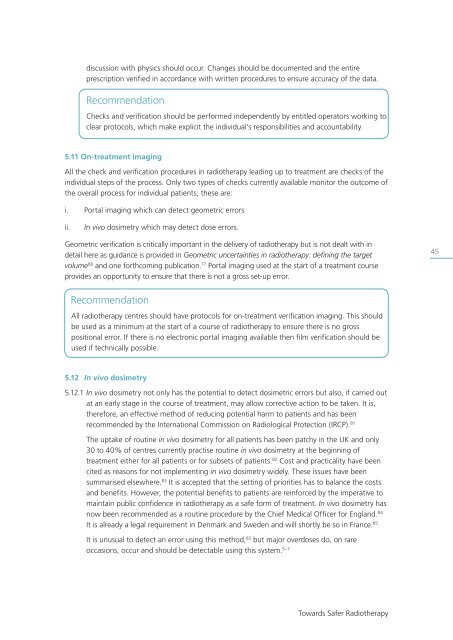Towards Safer Radiotherapy
Towards Safer Radiotherapy
Towards Safer Radiotherapy
You also want an ePaper? Increase the reach of your titles
YUMPU automatically turns print PDFs into web optimized ePapers that Google loves.
discussion with physics should occur. Changes should be documented and the entire<br />
prescription verified in accordance with written procedures to ensure accuracy of the data.<br />
Recommendation<br />
Checks and verification should be performed independently by entitled operators working to<br />
clear protocols, which make explicit the individual’s responsibilities and accountability.<br />
5.11 On-treatment imaging<br />
All the check and verification procedures in radiotherapy leading up to treatment are checks of the<br />
individual steps of the process. Only two types of checks currently available monitor the outcome of<br />
the overall process for individual patients; these are:<br />
i. Portal imaging which can detect geometric errors<br />
ii.<br />
In vivo dosimetry which may detect dose errors.<br />
Geometric verification is critically important in the delivery of radiotherapy but is not dealt with in<br />
detail here as guidance is provided in Geometric uncertainties in radiotherapy: defining the target<br />
volume 80 and one forthcoming publication. 77 Portal imaging used at the start of a treatment course<br />
provides an opportunity to ensure that there is not a gross set-up error.<br />
45<br />
Recommendation<br />
All radiotherapy centres should have protocols for on-treatment verification imaging. This should<br />
be used as a minimum at the start of a course of radiotherapy to ensure there is no gross<br />
positional error. If there is no electronic portal imaging available then film verification should be<br />
used if technically possible.<br />
5.12 In vivo dosimetry<br />
5.12.1 In vivo dosimetry not only has the potential to detect dosimetric errors but also, if carried out<br />
at an early stage in the course of treatment, may allow corrective action to be taken. It is,<br />
therefore, an effective method of reducing potential harm to patients and has been<br />
recommended by the International Commission on Radiological Protection (IRCP). 81<br />
The uptake of routine in vivo dosimetry for all patients has been patchy in the UK and only<br />
30 to 40% of centres currently practise routine in vivo dosimetry at the beginning of<br />
treatment either for all patients or for subsets of patients. 82 Cost and practicality have been<br />
cited as reasons for not implementing in vivo dosimetry widely. These issues have been<br />
summarised elsewhere. 83 It is accepted that the setting of priorities has to balance the costs<br />
and benefits. However, the potential benefits to patients are reinforced by the imperative to<br />
maintain public confidence in radiotherapy as a safe form of treatment. In vivo dosimetry has<br />
now been recommended as a routine procedure by the Chief Medical Officer for England. 84<br />
It is already a legal requirement in Denmark and Sweden and will shortly be so in France. 85<br />
It is unusual to detect an error using this method, 83 but major overdoses do, on rare<br />
occasions, occur and should be detectable using this system. 5–7<br />
<strong>Towards</strong> <strong>Safer</strong> <strong>Radiotherapy</strong>



